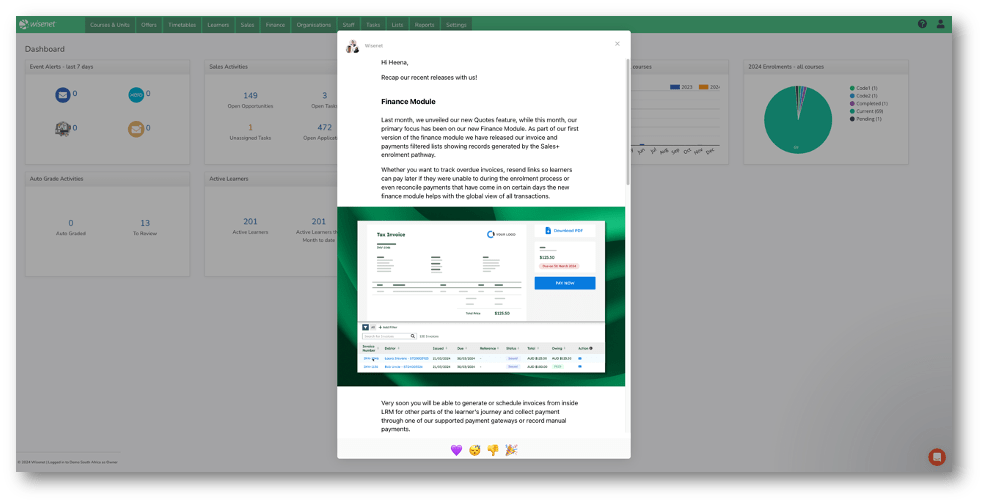Wisenet is committed to improving it’s features from the feedback we receive from you on how we can make our product better. We have a common process of testing some behind the scene features that will enable us to make updates and improvements more rapidly and efficiently for you. Periodically when a release occurs we will communicate the changes to you via a Pop-Up Notification when you log into Wiseset and/or via Email. Detailed Release Notes can be found in the Releases section of our Resources site.
Release Notes explains the purpose of the Release, about new features and details about what has changed and/or improved.
Keep reading below to find out more detailed information about Wisenet Releases.
Version and Updates
Which version of Wisenet LRM is my Training Organisation using?
All Wisenet users are always on the most recent version of Wisenet. As such, we do not have version numbers as we release any changes and enhancements to all users at the same time.
How do I update my Wisenet LRM database?
You don’t have to do anything – we do all the hard work for you. We will communicate details about the release. You and your team will automatically have access to the updates the first time you log in after the release date and time.
Release Process
What happens during a release?
All releases are done behind the scene without disturbing your login sessions and use of the Wisenet platform for the following areas:
- Wisenet Portal
- Wisenet LRM
- Learner App
How often does Wisenet do a release?
Minor releases are done any day throughout the week for product update, improvement and bug fixes.
Generally, we aim to do a major release once every 8-12 weeks. Sometimes it’s more often, sometimes less often.
How does Wisenet communicate releases?
Wisenet has a multi-channel communication strategy. For every release, we communicate release dates and details like this:
Detailed Release Notes can be found in the Releases section of Wisenet Resources website
If a release is only effective for you then Wisenet will send you an Email explaining the purpose and impacts of the release
In the rare instance that we may have to put an application on maintenance, i.e. Sales+, we will email you an alert to notify you of the release date, time, maintenance period and what systems will be affected.
Feature Development and Prioritisation
How do we prioritise what is released?
Product management planning needs to weigh up many different things:
We use an agile development and release model. This means that we analyse the requirements, develop the design, then do extensive testing prior to the release.
Using this model, we can sometimes add in additional features and enhancements earlier than planned. Occasionally, it also means that we may identify some features take longer to develop than anticipated. If this is the case, we will communicate this through our release lead up period.
The benefit to you is that we:
- Have the flexibility to deploy new compliance requirements with short notice from government departments
- Can often accommodate requests for new features or enhancements that may arise during a release cycle
- We can apply quick fixes if any issues are identified
How to make suggestions and give feedback
We welcome suggestions and feedback on how to make our Learner Admin and Integration Platform even better. Please log a support request outlining your ideas and we will be happy to consider them.
We will give priority to suggestions and feedback that will benefit a wide number of users – as such, we may not be able to accommodate requests that are very specific to your organisation.
Please note that our development process includes analysis, prioritisation, design, testing and launch stages before a new feature or enhancement becomes available. This means that we can accommodate some requests very quickly, whilst others may have a very long development process. In addition, changes to compliance may mean that we need to put some development ideas on hold until these are deployed.

